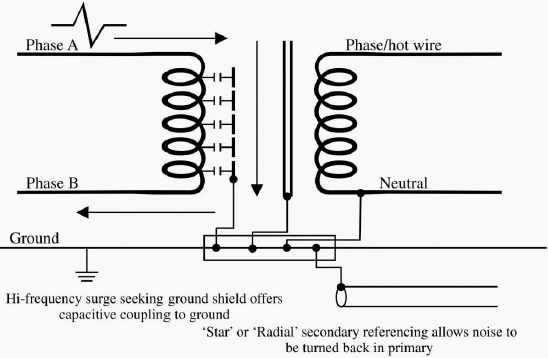E-Core can have better
electrical insulation between high voltage and low voltage side,
if they are provided with a copper shield between layers. Almost nobody makes E-I cores with coils on separate legs, because they will leak more magnetic field, so that is not an advantage.
However, they will "spill" more
magnetic field around them and in between them. Sometimes the separated digital and analog transformers are angled at 90 degrees to compensate for that and sometimes are shielded with a magnetic steel enclosure.
Those
shielded electrically (copper foil between layers) and magnetically (steel enclosure) are the best in my view. Sometimes they are triple shielded electrically - copper foils between core-primary, primary-secondary, secondary-outer core. Sometimes the primary is wounded last to minimize the capacitive coupling.
Toroidal transformers don't "leak" magnetic field so they don't need a magnetic shield. However they seldom have electrical shield between coils, so some degree of electric "leakage" will happen. Proper design and grounding the equipment (three prong cable and outlet) can take care of that.
Wall-Warts are seldom good - only
if they purely transformer type and
if they are (over-)sized properly. But they seldom are... because of costs and third party suppliers. They seldom have the copper shield between coils, so there will be some electric coupling. That's why the bad reputation. Why they are used? Well the idea is to take the magnetic influence out of DAC enclosure, instead of shielding it inside. Hmm... but then you have just one transformer for both digital and analog stages. I don't care what the design is, that's never providing a "clean" enough power for the analog section.
Since almost never they have the ground pin, they are not grounded and they will "push" any electrical stray currents towards the DAC and from there to any other equipment that is really grounded (amplifier), via analog cable shields. Stray currents will try to reach the ground no matter what and going there trough the analog ground shields... that's bad.
Note that lots of new Wall-Warts are just Switched-Mode Power Supplies. Lots of electrical noise, some magnetic noise too, and what's worse it is in a high-frequency range. That propagates easier, it can travel on the surface of shielded cables and is hard to ground properly - every wire has an inductance that will make a higher impedance (resistance equivalent in AC) for the high frequency signals. If for 50-60 Hz the ground wire presents a 1 ohm impedance, for a 30kHz parasite signal that impedance can be 300-600 ohms or even more. Now that "ground" is not really a ground anymore, so the parasitic HF signal cannot be bleed out that easy.
Example of the "good stuff":
And a pic for the shielding stuff that I have talked about:


.jpg)

